Doctor Who: The War Games, Part 1
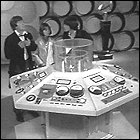 The 244th episode of Doctor Who airs on the BBC. Jane Sherwin, David Savile and Philip Madoc guest star. This is Patrick Troughton’s final story as the incumbent Doctor, the final Doctor Who story of the 1960s, and the final story made in black & white.
The 244th episode of Doctor Who airs on the BBC. Jane Sherwin, David Savile and Philip Madoc guest star. This is Patrick Troughton’s final story as the incumbent Doctor, the final Doctor Who story of the 1960s, and the final story made in black & white.
More about Doctor Who in the LogBook
Order VWORP!1 from theLogBook.com Store

 ABC airs the 26th episode of Irwin Allen’s sci-fi series Land Of The Giants, starring Gary Conway, Don Matheson, Deanna Lund, and Don Marshall. This episode concludes the first season.
ABC airs the 26th episode of Irwin Allen’s sci-fi series Land Of The Giants, starring Gary Conway, Don Matheson, Deanna Lund, and Don Marshall. This episode concludes the first season.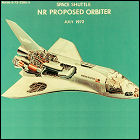 NASA formally asks various major players in the aerospace industry for proposals for what the agency sees as its two major projects for the 1970s: an orbiting space station and a reusable Space Shuttle to make routine flights from Earth to the station – which NASA hopes will be a “50 man space base” – and back again, with supplies, experiments, and new crew members. (Within mere weeks, the hypothetical station’s equally hypothetical crew will be downsized to a dozen.) In the event that the development curve on the Space Shuttle proves to be a long one, NASA says it will keep Apollo and even Gemini spacecraft in service to make flights to the station.
NASA formally asks various major players in the aerospace industry for proposals for what the agency sees as its two major projects for the 1970s: an orbiting space station and a reusable Space Shuttle to make routine flights from Earth to the station – which NASA hopes will be a “50 man space base” – and back again, with supplies, experiments, and new crew members. (Within mere weeks, the hypothetical station’s equally hypothetical crew will be downsized to a dozen.) In the event that the development curve on the Space Shuttle proves to be a long one, NASA says it will keep Apollo and even Gemini spacecraft in service to make flights to the station.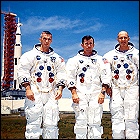 Apollo 10 lifts off for a dress rehearsal over the moon. Thomas Stafford, Gene Cernan and John Young fly a complete Apollo stack – both the command/service module and the lunar model – to the moon, conducting practice maneuvers in lunar orbit. Over eight days, the Apollo 10 crew does everything but land on the moon. With the mission requirements fulfilled, NASA announces that the next Apollo mission will attempt an actual landing.
Apollo 10 lifts off for a dress rehearsal over the moon. Thomas Stafford, Gene Cernan and John Young fly a complete Apollo stack – both the command/service module and the lunar model – to the moon, conducting practice maneuvers in lunar orbit. Over eight days, the Apollo 10 crew does everything but land on the moon. With the mission requirements fulfilled, NASA announces that the next Apollo mission will attempt an actual landing.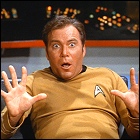 The
The 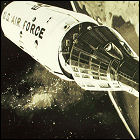 The Air Force officially cancels its plans for Manned Orbiting Laboratory, a space station in development that would have used Gemini capsules and technology to build and maintain a military outpost in space. The airmen selected as MOL crew members are transferred to NASA, where some of them will go on to fly the Space Shuttle, a vehicle whose design is still in its infancy at this point. The Air Force is also consulted on its military satellite launch needs, which are taken into account in the design of the shuttle.
The Air Force officially cancels its plans for Manned Orbiting Laboratory, a space station in development that would have used Gemini capsules and technology to build and maintain a military outpost in space. The airmen selected as MOL crew members are transferred to NASA, where some of them will go on to fly the Space Shuttle, a vehicle whose design is still in its infancy at this point. The Air Force is also consulted on its military satellite launch needs, which are taken into account in the design of the shuttle. The BBC announces that popular radio comedian Jon Pertwee will become Doctor Who‘s new star. With his penchant for character voices and other gags, the show’s producers – who will also be departing after the new Doctor’s installation – expect that Pertwee, and the series, will continue in a light-hearted vein with an increasingly comedic element. Though Pertwee’s first four-part story as the Doctor will reflect this thinking, the actor will actually take the role of the Doctor in a far more dramatic direction.
The BBC announces that popular radio comedian Jon Pertwee will become Doctor Who‘s new star. With his penchant for character voices and other gags, the show’s producers – who will also be departing after the new Doctor’s installation – expect that Pertwee, and the series, will continue in a light-hearted vein with an increasingly comedic element. Though Pertwee’s first four-part story as the Doctor will reflect this thinking, the actor will actually take the role of the Doctor in a far more dramatic direction.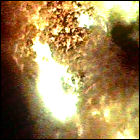 The Soviet Union’s second attempt to launch its moon rocket, the huge N1, ends disastrously. Again carrying an unmanned Zond spacecraft, the N1 barely clears the tower before stalling. Still full of highly flammable fuel, the N1 drops back to the ground, resulting in one of the most powerful man-made, non-nuclear explosions in history, completely wiping its launch tower and adjacent buildings off the map. (The Zond probe is lifted clear of the explosion by its escape rockets.) American spy satellites spot the damage to the nearby landscape from the explosion, tipping off the rest of the world to the N1 rocket program.
The Soviet Union’s second attempt to launch its moon rocket, the huge N1, ends disastrously. Again carrying an unmanned Zond spacecraft, the N1 barely clears the tower before stalling. Still full of highly flammable fuel, the N1 drops back to the ground, resulting in one of the most powerful man-made, non-nuclear explosions in history, completely wiping its launch tower and adjacent buildings off the map. (The Zond probe is lifted clear of the explosion by its escape rockets.) American spy satellites spot the damage to the nearby landscape from the explosion, tipping off the rest of the world to the N1 rocket program.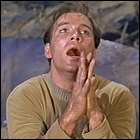 Picked up by the BBC as a summer replacement for Doctor Who, which has just ended its sixth season with the departure of its entire cast, Star Trek begins its run on BBC1 with the episode
Picked up by the BBC as a summer replacement for Doctor Who, which has just ended its sixth season with the departure of its entire cast, Star Trek begins its run on BBC1 with the episode 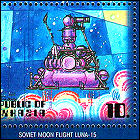 The Soviet Union launches unmanned space probe Luna 15 toward the moon, the Soviet space program’s last attempt to claim a victory in the race to the moon. Intended to land on the moon and gather a core sample of lunar soil which will then be rocketed back to Earth, hopefully ahead of the arrival of lunar soil samples from the concurrent American Apollo 11 moon landing attempt, Luna 15’s lander detaches and attempts its landing on July 20th…only to crash into the moon’s surface, losing all contact with Earth, while NASA astronauts Neil Armstrong and Buzz Aldrin prepare to depart with their soil samples intact. In a rare display of international cooperation, the Soviets shared basic orbital parameters of Luna 15’s flight with NASA to avoid any navigational hazards for Apollo 11.
The Soviet Union launches unmanned space probe Luna 15 toward the moon, the Soviet space program’s last attempt to claim a victory in the race to the moon. Intended to land on the moon and gather a core sample of lunar soil which will then be rocketed back to Earth, hopefully ahead of the arrival of lunar soil samples from the concurrent American Apollo 11 moon landing attempt, Luna 15’s lander detaches and attempts its landing on July 20th…only to crash into the moon’s surface, losing all contact with Earth, while NASA astronauts Neil Armstrong and Buzz Aldrin prepare to depart with their soil samples intact. In a rare display of international cooperation, the Soviets shared basic orbital parameters of Luna 15’s flight with NASA to avoid any navigational hazards for Apollo 11.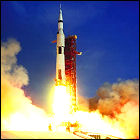 Apollo 11 lifts off, with astronauts Neil Armstrong, Buzz Aldrin and Michael Collins aboard. This is the first mission scheduled to attempt a landing on the moon, with Armstrong and Aldrin aboard the lunar module while Collins remains in orbit in the command/service module.
Apollo 11 lifts off, with astronauts Neil Armstrong, Buzz Aldrin and Michael Collins aboard. This is the first mission scheduled to attempt a landing on the moon, with Armstrong and Aldrin aboard the lunar module while Collins remains in orbit in the command/service module.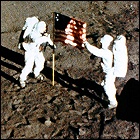 The Apollo 11 lunar module touches down in the Sea of Tranquility, a flat plain on the moon. Astronaut Neil Armstrong is the first human being to set foot on another body in the solar system, followed by “Buzz” Aldrin; the two spend roughly two and a half hours on the moon and gather nearly 50 pounds of samples of lunar soil and rock. This feat effectively ends the Cold War space race, though both the United States and the Soviet Union continue their lunar efforts: more Apollo missions are still on the schedule, and the Soviet continue trying to mount a successful launch of their giant N1 rocket.
The Apollo 11 lunar module touches down in the Sea of Tranquility, a flat plain on the moon. Astronaut Neil Armstrong is the first human being to set foot on another body in the solar system, followed by “Buzz” Aldrin; the two spend roughly two and a half hours on the moon and gather nearly 50 pounds of samples of lunar soil and rock. This feat effectively ends the Cold War space race, though both the United States and the Soviet Union continue their lunar efforts: more Apollo missions are still on the schedule, and the Soviet continue trying to mount a successful launch of their giant N1 rocket. Another round of tape-wiping eliminates more of the recorded history of Doctor Who at the BBC. The instructions to erase the final remaining Hartnell-era episodes go out, as well as an order to get rid of much of Patrick Troughton’s era. Where previous episode wiping sprees may have been sparked by a looming change of video standards, these latest erasures are more likely the result of BBC1’s impending switch from black & white to color after the successful launch of color broadcasting on BBC2 in 1967. The BBC deems non-news-related black & white material commercially unviable with the advent of color TV just around the corner – a decision that Doctor Who fans (and the BBC’s home video department) will regret years later. While many of the Hartnell episodes are recoverable from foreign markets at a later date, much of the Troughton era is lost forever – mere weeks after initial broadcast.
Another round of tape-wiping eliminates more of the recorded history of Doctor Who at the BBC. The instructions to erase the final remaining Hartnell-era episodes go out, as well as an order to get rid of much of Patrick Troughton’s era. Where previous episode wiping sprees may have been sparked by a looming change of video standards, these latest erasures are more likely the result of BBC1’s impending switch from black & white to color after the successful launch of color broadcasting on BBC2 in 1967. The BBC deems non-news-related black & white material commercially unviable with the advent of color TV just around the corner – a decision that Doctor Who fans (and the BBC’s home video department) will regret years later. While many of the Hartnell episodes are recoverable from foreign markets at a later date, much of the Troughton era is lost forever – mere weeks after initial broadcast.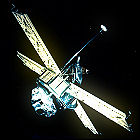 Just two days before its sister ship Mariner 6 makes its closest flyby of Mars, NASA/JPL’s unmanned space explorer Mariner 7 loses all contact with Earth. Ground controllers race to find a solution, re-establishing communications via Mariner 7’s low-gain antenna, which can only return data at a reduced speed and bandwidth. Its high-gain antenna resumes normal operation shortly after Mariner 6’s closest pass by Mars, allowing Mariner 7 to complete its mission as planned.
Just two days before its sister ship Mariner 6 makes its closest flyby of Mars, NASA/JPL’s unmanned space explorer Mariner 7 loses all contact with Earth. Ground controllers race to find a solution, re-establishing communications via Mariner 7’s low-gain antenna, which can only return data at a reduced speed and bandwidth. Its high-gain antenna resumes normal operation shortly after Mariner 6’s closest pass by Mars, allowing Mariner 7 to complete its mission as planned.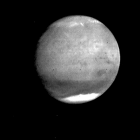 The unmanned NASA/JPL space probe Mariner 6 makes its closest flyby of planet Mars, coming as close as just over 2100 miles from the Martian surface. While measuring the composition of the Martian atmosphere and trying to analyze its surface from space, Mariner 6 passes over densely cratered terrain, not spotting the huge canyons and volcanoes that will later become synonymous with Mars. Mariner 6’s identical twin, Mariner 7, is just days behind it, and ground controllers rewrite Mariner 7’s flight plan to get closer looks at surface features first spotted by Mariner 6.
The unmanned NASA/JPL space probe Mariner 6 makes its closest flyby of planet Mars, coming as close as just over 2100 miles from the Martian surface. While measuring the composition of the Martian atmosphere and trying to analyze its surface from space, Mariner 6 passes over densely cratered terrain, not spotting the huge canyons and volcanoes that will later become synonymous with Mars. Mariner 6’s identical twin, Mariner 7, is just days behind it, and ground controllers rewrite Mariner 7’s flight plan to get closer looks at surface features first spotted by Mariner 6.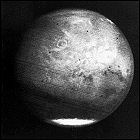 The unmanned NASA/JPL space probe Mariner 7 makes its closest flyby of planet Mars, coming as close as just over 2100 miles from the Martian surface. Having recently suffered an inexplicable but temporary loss of communications with Earth (later determined to be caused by a leaky on-board battery), Mariner 7’s flight plan is reprogrammed just days out from Mars based on some of the more interesting findings of its sister ship, Mariner 6. The success of the tandem flight to Mars convinces NASA to adopt a similar mission profile for the upcoming Mars ’71 missions, which will send two Mariner orbiters to take up permanent positions around Mars.
The unmanned NASA/JPL space probe Mariner 7 makes its closest flyby of planet Mars, coming as close as just over 2100 miles from the Martian surface. Having recently suffered an inexplicable but temporary loss of communications with Earth (later determined to be caused by a leaky on-board battery), Mariner 7’s flight plan is reprogrammed just days out from Mars based on some of the more interesting findings of its sister ship, Mariner 6. The success of the tandem flight to Mars convinces NASA to adopt a similar mission profile for the upcoming Mars ’71 missions, which will send two Mariner orbiters to take up permanent positions around Mars.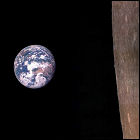 The Soviet Union launches the Zond 7 unmanned spacecraft, an unmanned version of the Soyuz 7K-L1 space vehicle intended to take cosmonauts around the moon. Carrying no crew, this vehicle takes pictures and tests various spacecraft systems without risking human lives. Zond 7 returns to Earth using an unusual multiple-skip atmospheric re-entry profile on August 14th. If Zond 7 had been carrying a crew, this would have been the first nominal flight of the Soyuz 7K-L1 vehicle. No cosmonaut crews would reach the moon prior to the dissolution of the Soviet Union in the late 20th century.
The Soviet Union launches the Zond 7 unmanned spacecraft, an unmanned version of the Soyuz 7K-L1 space vehicle intended to take cosmonauts around the moon. Carrying no crew, this vehicle takes pictures and tests various spacecraft systems without risking human lives. Zond 7 returns to Earth using an unusual multiple-skip atmospheric re-entry profile on August 14th. If Zond 7 had been carrying a crew, this would have been the first nominal flight of the Soyuz 7K-L1 vehicle. No cosmonaut crews would reach the moon prior to the dissolution of the Soviet Union in the late 20th century. The first episode of the mystery/spy-fi series Strange Report premieres on ITV, starring Anthony Quayle, Kaz Garas, and Anneke Wills (Doctor Who). The series is an international co-production (and airs in the United States on NBC). Ed Bishop (UFO) guest stars.
The first episode of the mystery/spy-fi series Strange Report premieres on ITV, starring Anthony Quayle, Kaz Garas, and Anneke Wills (Doctor Who). The series is an international co-production (and airs in the United States on NBC). Ed Bishop (UFO) guest stars.